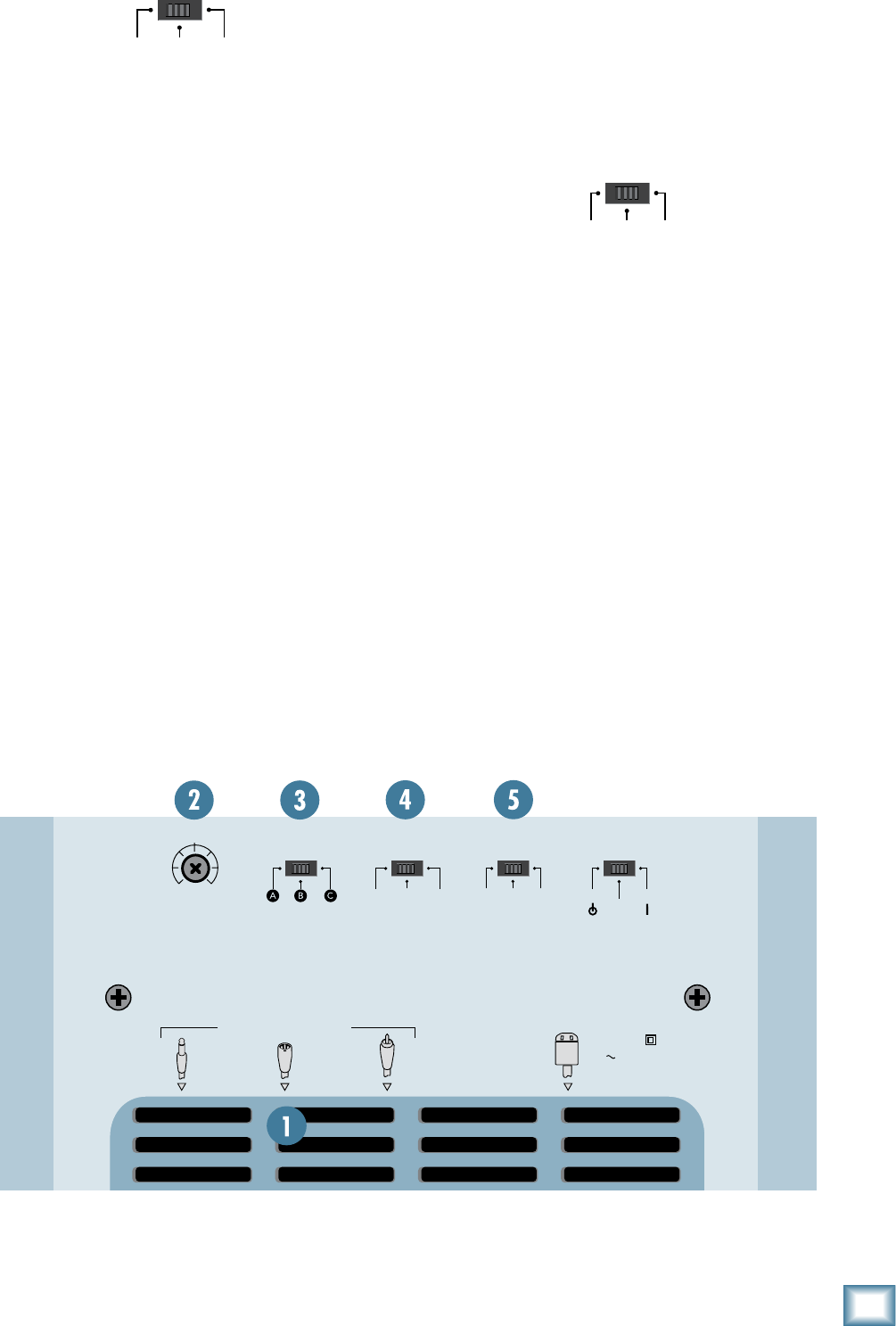
9
Owner’s Manual
Owner’s Manual
AUTO
STANDBY
ON
MAINS INPUT
120VAC
60 Hz 150W
SIGNAL INPUTS BAL/UNBAL
ACOUSTIC SPACE
0dB
–
2dB
–
3dB
–
4
dB
20 100Hz
LOW FREQ
LOW CUT
24dB/oct
LOW CUT
BUTTERWORTH
47Hz
80Hz
HIGH FREQ
0dB
–
2dB
10kHz
+
2dB
ACOUSTIC SPACE APPLICATIONS
C
SPEAKERS AGAINST WALLSPEAKERS IN CORNERS
B
CONSOLE
CONSOLE
A
HALF SPACE
QUARTER SPACE
37Hz
SPEAKERS AWAY FROM WALLS
CONSOLE
WHOLE SPACE
XLRPHONE
0
dB
RCA
ON
ACOUSTIC SPACE LOW FREQ HIGH FREQ. POWER MODE
NORMALOFF
HALFQUARTER
WHOLE
(
NORMAL
)
37Hz80Hz
0
(
NORMAL
)
–
2dB
+
2dB
47Hz
INPUT
SENSITIVITY
LOW CUT
–
10dB
(
NORMAL
)
PATENT NO:
DES. 387,351
DESIGNED BY MACKOIDS IN WOODINVILLE, WA, USA • MANUFACTURED IN CHINA • FABRIQUE EN CHINE • COPYRIGHT ©2007
"MACKIE", "FR SERIES" AND THE RUNNING MAN FIGURE ARE TRADEMARKS OF LOUD TECHNOLOGIES, INC. • PATENT PENDING
SERIAL NUMBER
MANUFACTURING DATE
RISK OF ELECTRIC SHOCK
DO NOT OPEN
REPLACE WITH THE SAME TYPE FUSE AND RATING.
DISCONNECT SUPPLY CORD BEFORE CHANGING FUSE
UTILISE UN FUSIBLE DE RECHANGE DE MÊME TYPE.
DEBRANCHER AVANT DE REMPLACER LE FUSIBLE
WARNING:
TO REDUCE THE RISK OF FIRE OR ELECTRIC SHOCK, DO NOT
EXPOSE THIS EQUIPMENT TO RAIN OR MOISTURE. DO NOT REMOVE COVER.
NO USER SERVICEABLE PARTS INSIDE. REFER SERVICING TO QUALIFIED PERSONNEL.
AVIS:
RISQUE DE CHOC ELECTRIQUE — NE PAS OUVRIR
This device complies with part 15 of the FCC Rules.
Operation is subject to the following two conditions:
(1) This device may not cause harmful interference, and
(2) This device must accept any interference received,
including interference that may cause undesired operation.
INTERNAL BI•AMPLIFICATION
150W. L.F. / 100W. H.F.
™
THE THX LOGO AND PM3 ARE TRADEMARKS OF THX LTD. WHICH MAY BE REGISTERED IN SOME JURISDICTIONS.
ALL RIGHTS REVERVED
ROHS
Removing the low-frequency content also allows
you to raise the overall output level somewhat. Low-
frequency information requires the largest amount of
an amplifier’s output, so restricting the low-frequency
content allows raising the mid-frequency level some-
what. If your client insists on mixing LOUD, this may be
a workable strategy.
. HIGH FREQ FILTER
AUTO
STANDBY
ON
ON
ACOUSTIC SPACE LOW FREQ HIGH FREQ. POWER MODE
NORMALOFF
HALFQUARTER
WHOLE
(
NORMAL
)
37Hz80Hz
0
(
NORMAL
)
–
2dB
+
2dB
47Hz
INPUT
SENSITIVITY
LOW CUT
–
10dB
(
NORMAL
)
THX = 0 dB
The HIGH FREQ FILTER switch tailors the overall
high-frequency response by ±2 dB beginning at 10kHz.
Leave this switch in the 0 (NORMAL) position unless:
• You want to subtly brighten or darken the sound of the
speakers.
• Perhaps you have hearing loss caused by too many
nights in front of a double Marshall stack.
• You just like to mix on the bright side or dull side.
If your mixes consistently sound dull or dark when
you listen elsewhere, this usually indicates that your
monitors are too bright, relative to your normal hearing.
A bit less high-frequency energy usually fixes this, and
you can force the mix in this direction by reducing the
high-frequency output of the monitors by using the –2 dB
position of the switch.
4. LOW FREQ FILTER
AUTO
STANDBY
ON
ON
ACOUSTIC SPACE LOW FREQ HIGH FREQ. POWER MODE
NORMALOFF
HALFQUARTER
WHOLE
(
NORMAL
)
37Hz80Hz
0
(
NORMAL
)
–
2dB
+
2dB
47Hz
INPUT
SENSITIVITY
LOW CUT
–
10dB
(
NORMAL
)
THX = 80Hz
The LOW FREQ FILTER switch inserts a low-frequency
rolloff into the response curve.
• For some applications, the low-frequency output of the
HR824 MK2 may impair your ability to make mix judge-
ments.
• For THX applications, use the 80Hz setting.
• For non-THX applications where a sub-woofer isn’t en
-
hancing low-frequency output use the 37Hz (NORMAL)
position.
• The LOW FREQ switch affects the low-frequency con
-
tent of your mix. Remember how things work in reverse,
so removing the deep bass content on playback may
actually increase it in the final mix.
• You can use the LOW FREQ switch’s 80Hz position to
simulate a smaller loudspeaker, especially one with
limited low-frequency capability (like a certain popular
2-way nearfield monitor). You may need to do this if a
small speaker is the eventual destination of your mix,
or perhaps just to see how your mix sounds on a clock
radio.


















